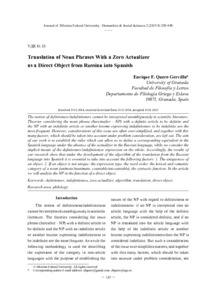Показать сокращенную информацию
Translation of Noun Phrases With a Zero Actualizer as a Direct Object from Russian into Spanish
| Автор | Quero Gervilla, Enrique F. | en |
| Автор | Керо Хервилья, Энрике Федерико | ru_RU |
| Дата внесения | 2015-02-27T06:12:11Z | |
| Дата, когда ресурс стал доступен | 2015-02-27T06:12:11Z | |
| Дата публикации | 2015-02 | |
| URI (для ссылок/цитирований) | https://elib.sfu-kras.ru/handle/2311/16680 | |
| Аннотация | The notion of definiteness/indefiniteness cannot be interpreted unambiguously in scientific literature. Theories considering the noun phrase (hereinafter – NP) with a definite article to be definite and the NP with an indefinite article or another lexeme expressing indefiniteness to be indefinite are the most frequent. However, considerations of this issue are often over-simplified, and together with this many factors, which should be taken into account under problem consideration, are left out. The aim of our work is to establish the rules which can allow us to define a corresponding equivalent in the Spanish language under the absence of the actualizer in the Russian language, while we consider the implicit means of the definiteness/indefiniteness expression on the whole. Accordingly, the results of our research show that under the development of the algorithm of the translation from the Russian language into Spanish it is essential to take into account the following factors: 1. The uniqueness of an object. 2. If an object is not unique: the expression type, the word order, the lexical and semantic category of a noun (animate/inanimate, countable/uncountable), the syntactic function. In the article we will analyze the NP in the function of a direct object | en |
| Аннотация | Понятие определенности-неопределенности не имеет однозначной трактовки в научной литературе. Наиболее распространенными являются теории, в которых определенной считается именная группа (далее – ИГ) с определенным артиклем, а неопределенной – ИГ с неопределенным артиклем или с любой другой лексемой, выражающей неопределенность. Цель данной работы – установить правила, позволяющие определить соответствующий эквивалент в испанском языке при условии отсутствия актуализатора в русском, рассматривая имплицитные способы выражения определенности-неопределенности в русском языке в совокупности. Результаты нашего исследования показывают, что при разработке алгоритма перевода с русского языка на испанский необходимо учитывать следующие факторы: 1. Уникальность предмета. 2. Если предмет не уникален: тип высказывания, порядок слов, лексико-семантический разряд существительного (одушевленность-неодушевленность; исчисляемость-неисчисляемость), синтаксическую функцию. В данной статье анализируются именные группы в функции прямого дополнения | ru_RU |
| Язык | en | en |
| Издатель | Сибирский федеральный университет. Siberian Federal University. | en |
| Является частью серии | Журнал Сибирского федерального университета. Гуманитарные науки. Journal of Siberian Federal University. Humanities & Social Sciences;2015 8 (2) | en |
| Тема | definiteness | en |
| Тема | indefiniteness | en |
| Тема | zero actualizer | en |
| Тема | algorithm | en |
| Тема | translation | en |
| Тема | direct object | en |
| Тема | определенность | ru_RU |
| Тема | неопределенность | ru_RU |
| Тема | нулевой актуализатор | ru_RU |
| Тема | алгоритм | ru_RU |
| Тема | перевод | ru_RU |
| Тема | прямое дополнение | ru_RU |
| Название | Translation of Noun Phrases With a Zero Actualizer as a Direct Object from Russian into Spanish | en |
| Альтернативное название | Перевод именных групп с нулевым актуализатором в функции прямого дополнения с русского языка на испанский | ru_RU |
| Тип | Journal Article | |
| Тип | Published Journal Article | |
| Контакты автора | Gervilla, Enrique F. Quero:University of Granada Facultad de Filosofía y Letras Departamento de Filología Griega y Eslava 18071, Granada, Spain; E-mail: efquero@gmail.com, efquero@ugr.es | en |
| Контакты автора | Хервилья, Энрике Федерико Керо:University of Granada Facultad de Filosofía y Letras Departamento de Filología Griega y Eslava 18071, Granada, Spain | ru_RU |
| Страницы | 329-348 |

